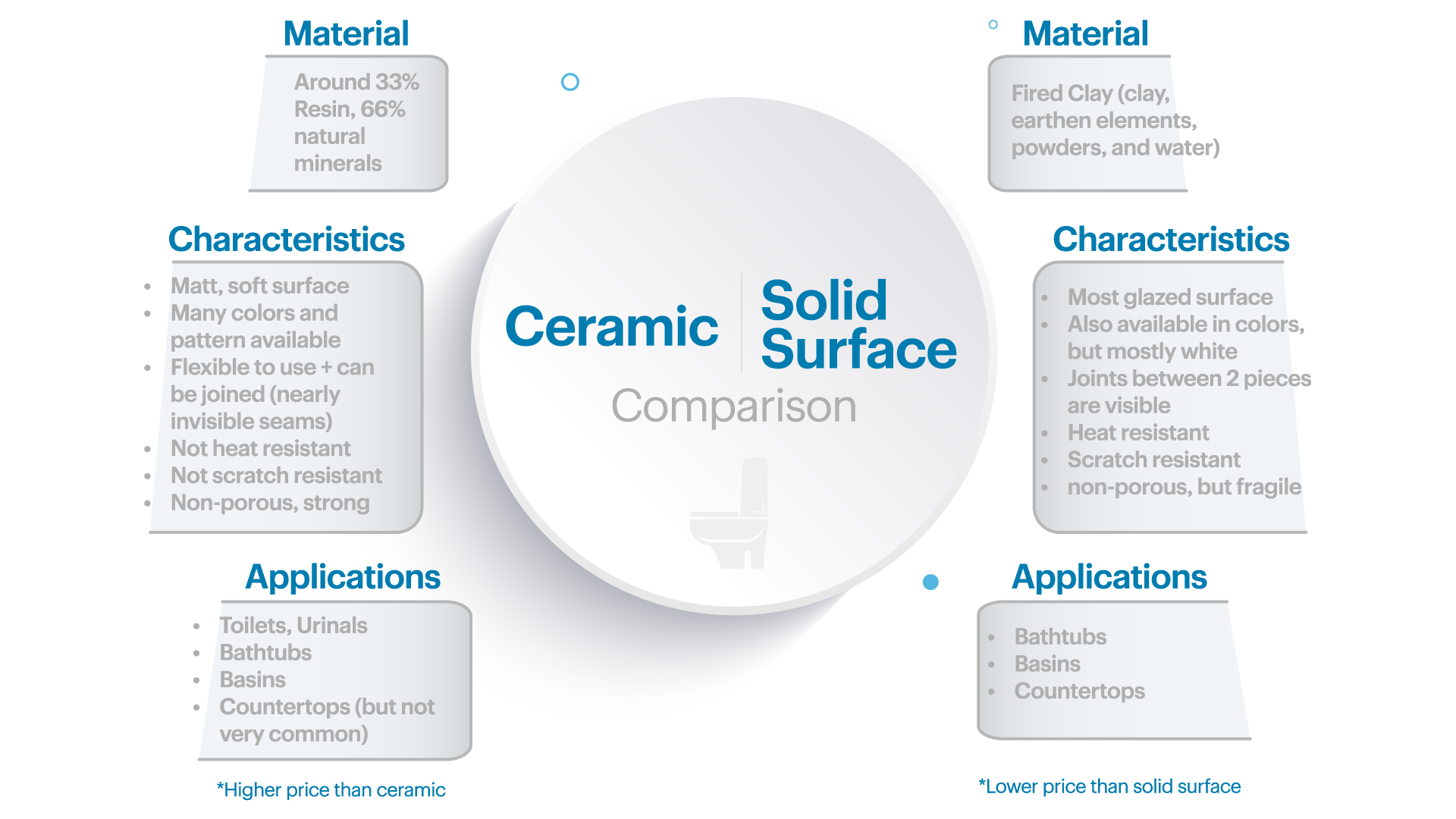Als het gaat om het ontwerpen van een badkamer, is een van de belangrijkste beslissingen het kiezen van het juiste sanitair. Dit omvat zowel hotel- als openbaar sanitair , die van cruciaal belang zijn voor het waarborgen van functionaliteit en hygiëne in drukbezochte ruimtes. Keramische en massieve oppervlaktematerialen zijn twee populaire opties die duurzaamheid, esthetiek en functionaliteit bieden. In dit artikel vergelijken we keramisch en massief oppervlakte sanitair om u te helpen bepalen welke de beste keuze is voor uw badkamer. Van materiaalsamenstelling tot onderhoudsvereisten, we onderzoeken de verschillen tussen deze twee opties, zodat u een weloverwogen beslissing kunt nemen voor uw volgende badkamerrenovatieproject. Laten we duiken in de wereld van sanitair en ontdekken welke optie het beste bij uw behoeften past.
Materiaalsamenstelling: de verschillen tussen keramische en massieve oppervlaktematerialen begrijpen
Laten we eens kijken naar de materialen die worden gebruikt om keramiek en massieve oppervlakken te maken om de fundamentele verschillen te begrijpen:
- Keramiek:
- Gemaakt van klei, mineralen en water.
- Gebakken op hoge temperaturen om een duurzaam oppervlak te creëren.
- Vast oppervlak:
- Een mengsel van acryl, polyesterharsen en mineralen.
- Door middel van gietprocessen in de gewenste vorm gebracht.
Als het aankomt op materiaalsamenstelling, biedt keramisch sanitair een traditionele maar robuuste optie met zijn klei-gebaseerde constructie. Omgekeerd bieden solid surface producten een modern alternatief door acryl en harsen te combineren voor veelzijdigheid in ontwerpmogelijkheden.
Duurzaamheid en levensduur: welke optie is het meest geschikt voor uw badkamer?
Als het aankomt op het inrichten van uw badkamer, zijn duurzaamheid en levensduur belangrijke factoren om te overwegen. De materialen die u kiest voor uw sanitair hebben een grote invloed op hoe goed uw badkamer de tand des tijds doorstaat. Laten we eens kijken naar de voor- en nadelen van twee populaire opties: keramiek en massief oppervlak.
Keramisch sanitair is al lang een populaire keuze voor badkamers vanwege de uitzonderlijke duurzaamheid. Het harde, dichte oppervlak van keramiek is zeer goed bestand tegen krassen, vlekken en chips, waardoor het ongelooflijk gemakkelijk schoon te maken en te onderhouden is. Met de juiste verzorging kunnen keramische armaturen tientallen jaren meegaan zonder hun glans of functionaliteit te verliezen. Deze levensduur zorgt ervoor dat uw badkamer nog vele jaren stijlvol en functioneel blijft.
Hoewel keramiek een onovertroffen duurzaamheid biedt, kan solid surface sanitair aantrekkelijk zijn voor degenen die op zoek zijn naar een meer eigentijdse en naadloze look. Deze armaturen zijn gemaakt van synthetische materialen die in verschillende vormen en kleuren kunnen worden gegoten. Solid surface is echter mogelijk niet zo duurzaam als keramiek. Het is gevoeliger voor krassen en schade, vooral als het wordt blootgesteld aan agressieve chemicaliën of schurende schoonmaakmiddelen. Na verloop van tijd kunnen solid surface armaturen sneller tekenen van slijtage vertonen dan hun keramische tegenhangers.
Uiteindelijk hangt de keuze tussen keramisch en solid surface sanitair af van uw prioriteiten. Als duurzaamheid en levensduur van het grootste belang zijn, is keramiek de duidelijke winnaar. Als esthetiek en een modernere look echter uw voornaamste zorgen zijn, kan solid surface een geschikte optie zijn. Denk goed na over uw levensstijl, schoonmaakgewoonten en langetermijndoelen bij het nemen van uw beslissing.
Esthetiek en design: vergelijking van de uitstraling en het gevoel van keramisch en massief sanitair
Als het op esthetiek aankomt, biedt keramisch sanitair een klassieke en tijdloze look die moeilijk te verslaan is. De glanzende afwerking van keramische wastafels en toiletten voegt een vleugje elegantie toe aan elke badkamer. Aan de andere kant heeft solid surface sanitair een modernere en strakkere uitstraling, met naadloze ontwerpen die een strakke en minimalistische look creëren.
Qua ontwerpopties komt keramisch sanitair vaak in traditionele vormen en stijlen die breed verkrijgbaar zijn op de markt. Solid surface sanitair biedt daarentegen meer flexibiliteit in ontwerpmogelijkheden vanwege de vormbare aard ervan. Dit maakt op maat gemaakte stukken mogelijk die kunnen worden aangepast aan individuele voorkeuren en unieke badkamerindelingen .
Over het algemeen hangt de keuze tussen keramisch en massief oppervlakte sanitair uiteindelijk af van persoonlijke stijlvoorkeuren en de gewenste esthetiek voor uw badkamerruimte. Of u nu de klassieke elegantie van keramiek of de moderne veelzijdigheid van massief oppervlaktematerialen prefereert, beide opties bieden duurzaamheid en functionaliteit terwijl ze de algehele uitstraling van uw badkamer verbeteren.
Installatie en kosten: factoren om te overwegen bij het kiezen tussen keramische en massieve oppervlakteopties
Installatie
Keramisch sanitair is doorgaans zwaarder dan solid surface-opties, wat de installatie arbeidsintensiever kan maken. Solid surface-producten zijn lichter en gemakkelijker te hanteren tijdens de installatie, wat mogelijk de arbeidskosten verlaagt. Beide materialen vereisen echter bekwame professionals voor een correcte installatie om een waterdichte afdichting en levensduur te garanderen.
Kosten
Wat betreft de initiële kosten is keramisch sanitair doorgaans betaalbaarder dan solid surface-opties. Het is echter essentieel om ook rekening te houden met de onderhoudskosten op de lange termijn. Keramiek kan na verloop van tijd gevoelig zijn voor afbrokkeling of barsten, wat kan leiden tot mogelijke reparatiekosten. Solid surface-producten staan bekend om hun duurzaamheid en slijtvastheid, wat op de lange termijn kan resulteren in lagere onderhoudskosten.
Bij het kiezen tussen keramisch en massief oppervlakte sanitair voor uw badkamer, is het cruciaal om de factoren van installatiecomplexiteit en algehele kostenimplicaties af te wegen. Hoewel initiële kosten in het voordeel kunnen zijn van keramische opties, kan het overwegen van onderhoudskosten op de lange termijn uw beslissing beïnvloeden om te investeren in duurzame oplossingen voor massief oppervlak voor een badkamer die de tand des tijds zal doorstaan.
Onderhoudseisen: Welk materiaal is op de lange termijn gemakkelijker schoon te maken en te onderhouden?
Als het aankomt op schoonmaken en onderhoud, vereist keramisch sanitair over het algemeen minder moeite dan solid surface-opties. Keramische oppervlakken zijn glad en niet-poreus, waardoor ze gemakkelijk af te nemen zijn met een vochtige doek of mild schoonmaakmiddel. Dit materiaal is ook bestand tegen vlekken en krassen, waardoor uw badkamerarmaturen er langer als nieuw uit blijven zien.
Aan de andere kant kan solid surface sanitair meer aandacht vereisen als het gaat om schoonmaken. De poreuze aard van dit materiaal kan het vatbaar maken voor vlekken als het niet goed wordt onderhouden. Om solid surface sanitair in topconditie te houden, wordt regelmatige reiniging met niet-schurende schoonmaakmiddelen aanbevolen. Houd rekening met uw levensstijl en mate van toewijding aan onderhoud bij het kiezen tussen keramische en solid surface opties voor uw badkamer.
- Keramiek: Gemakkelijk schoon te maken met een vochtige doek of een mild schoonmaakmiddel
- Solid Surface: vereist regelmatige reiniging met niet-schurende reinigingsmiddelen
Eco-vriendelijkheid: onderzoek naar de milieu-impact van keramisch en massief sanitair
- Keramisch sanitair heeft doorgaans een lagere impact op het milieu vergeleken met solid surface-opties. Het productieproces van keramiek omvat natuurlijke materialen zoals klei en water, waardoor het duurzamer is.
- Aan de andere kant wordt solid surface sanitair vaak geproduceerd met behulp van synthetische materialen die een hogere CO2-voetafdruk kunnen hebben. Bovendien kan de productie van solid surface materialen resulteren in meer afval.
Als u rekening houdt met milieuvriendelijkheid, is het wellicht verstandiger om te kiezen voor keramisch sanitair, omdat dit materiaal van natuurlijke grondstoffen wordt gemaakt en over het geheel genomen een kleinere ecologische voetafdruk heeft.
Aanpassingsopties: Welke optie biedt meer flexibiliteit qua ontwerp en aanpassing?
- Solid Surface Sanitary Ware : Deze optie biedt meer flexibiliteit in ontwerp en maatwerk vergeleken met keramiek. Met solid surface materialen kunt u de producten eenvoudig vormen en vormen zodat ze passen bij uw specifieke badkamerindeling. Bovendien kunnen deze oppervlakken worden aangepast met verschillende kleuren, patronen en texturen om te passen bij uw gewenste esthetiek.
- Keramisch sanitair : Hoewel keramisch sanitair duurzaam en makkelijk te onderhouden is, biedt het mogelijk minder flexibiliteit in termen van ontwerpaanpassing. Keramische stukken zijn doorgaans beschikbaar in een beperkt aantal vormen en maten, waardoor het lastig is om unieke of gepersonaliseerde badkamerontwerpen te maken met alleen dit materiaal. Als het aankomt op ingewikkelde ontwerpen of aangepaste kleuren, zijn opties voor een massief oppervlak wellicht een betere keuze voor degenen die op zoek zijn naar meer creatieve vrijheid in badkamerstijl.
Kortom, als u voor uw badkamerrenovatieproject prioriteit geeft aan flexibiliteit in het ontwerp en aanpassingsmogelijkheden, is sanitair van massief oppervlak mogelijk de beste keuze vanwege de veelzijdigheid in vorm- en kleurmogelijkheden.

Conclusie: De definitieve beslissing nemen of sanitair van keramiek of massief oppervlak de beste keuze is voor uw badkamer
Nadat u de voor- en nadelen van zowel keramisch als massief sanitair heeft overwogen, is het belangrijk om uw prioriteiten af te wegen bij het nemen van een beslissing voor uw badkamer.
- Duurzaamheid : Als duurzaamheid voor u het belangrijkst is, is keramisch sanitair wellicht de beste optie, omdat het bekendstaat om zijn sterkte en slijtvastheid.
- Personalisatie : Sanitair van massief oppervlak biedt meer flexibiliteit qua ontwerp- en kleuropties, waardoor u een unieke uitstraling in uw badkamer kunt creëren.
- Onderhoud : Sanitair van keramiek heeft op den duur minder onderhoud nodig dan sanitair van massieve oppervlakken, die sneller tekenen van slijtage kunnen vertonen.
Uiteindelijk komt de keuze tussen keramisch en solid surface sanitair neer op persoonlijke voorkeur, budgettaire overwegingen en de specifieke behoeften van uw huishouden. Door deze factoren zorgvuldig te evalueren, kunt u een weloverwogen beslissing nemen die ervoor zorgt dat u jarenlang een stijlvolle en functionele badkamer heeft.
PS: Als u geïnteresseerd bent in waar in China sanitair wordt gemaakt, raden wij u aan ons artikel over de productiehotspots in Guangdong.





